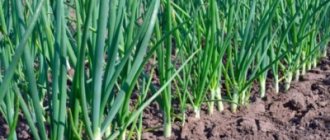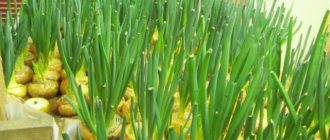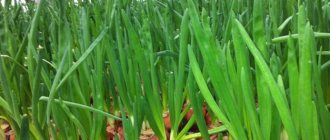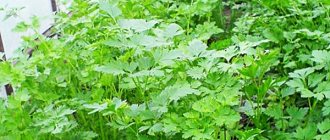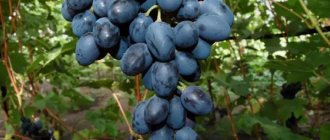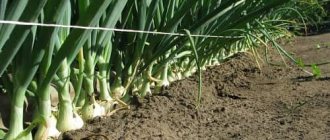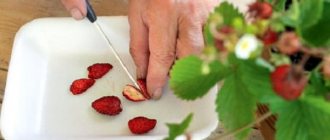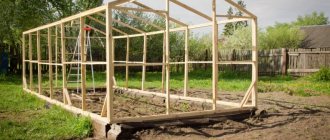Owners of private plots are wondering whether it is profitable to grow onions as greens in winter? This question may arise from a person who has never cooked food on his own. Any housewife knows perfectly well that it is impossible to live without this greenery either in summer or in winter. Its cultivation is possible not only on the windowsill in the house, but also in a greenhouse. Especially when there is a desire to get some profit from it.
It is important to remember that growing such a crop in a greenhouse in winter is very profitable for several reasons:
- it will be possible to achieve higher yields;
- this makes it possible to use racks in several tiers;
- this type of greenery will be available not only in winter, but also in other months;
- This is a very profitable business that brings in a solid income.
It is also necessary to remember that onions grown for greens in winter in a greenhouse are those vitamins that are so lacking in the cold season. But due to their insufficient quantity, you can encounter colds.
Varieties
Which onions for greens in a greenhouse in winter are best to deal with? Not all varieties of this crop are suitable to be grown in this way. It may turn out that you do everything right, invest a lot of effort and money into this business, but the profit turns out to be insignificant. And all because the wrong variety was chosen, since it grows poorly in such conditions or bears fruit late.
It is important to know: Not only late or mid-late, but even medium varieties are completely unsuitable for this purpose.
It is better to grow onions in winter in a greenhouse, which produce greens very quickly:
- Slime onion – great for year-round cultivation;
- Onions – characterized by high yield;
- Trampoline onion - in any winter month it will give a good harvest;
- Leek, the feather of which is somewhat similar to garlic, but has its own taste;
- The Egyptian variety is distinguished by the fact that it easily tolerates even frost. It is better to plant onion no earlier than December. It is very profitable to grow the Chinese variety, as it is a perennial plant.
What varieties should I choose for growing green feathers in a greenhouse made of polycarbonate and other materials?
You can grow green onions from onion varieties, the bulb of which has a diameter of about 3-4 cm. But not all of them are suitable for planting in a greenhouse. When choosing a variety, you need to consider the following factors:
- Number of primordia. They are visible in a cross section of the bulb. The rudiments look like separate nests of yellow-green color. This feature allows you to distinguish between single-germ and multi-germ onions. For growing for feathers, multi-germ is used because it is more prolific in greenery.
- Rest period. Green onions with a long dormant period grow longer in winter. For greenhouses, you should choose southern varieties with a short dormant period.
- Variety It is selected according to individual taste preferences, feather width and height, frost resistance, etc.
Slime (“Leader”, “Green”)
Contains a large amount of iron and vitamin C. The feathers of this species are wide, tall, and bright green. The taste of the onion gives off light notes of garlic, but the smell does not contain any admixture of garlic aroma.
The species is early ripening and sensitive to frost, so special attention should be paid to heating the greenhouse.
This type of onion is grown here all year round.
Batun (“Salad”, “Maysky”, “Local Ural”)
The feather of this species is long and wide, juicy. Productivity is high - up to 4 kg per 1 sq. m. The crop grows once a year.
Multi-tiered (“Gribovsky 38”, “Odessky Winter”).
Able to grow in greenhouses without increased heating, as it has high frost resistance . The yield is about 3 kg per 1 sq.m. and grows throughout the year. The green mass of this type of onion is thick and has a bright green color.
Shallot or Ashkelon (“May Day”)
This species is characterized by high frost resistance and early ripening. The feather tastes sweetish, and there is practically no smell.
Schnitt (“Pink”, “Siberian”)
This type of bow is very demanding on lighting. It has a delicate aroma and taste, the green feather grows up to 15 cm. The yield with proper care reaches up to 3.5 kg per 1 sq.m.
Greenhouse equipment
When planning to grow onions in a greenhouse in winter, you need to prepare everything correctly. It is important to equip the greenhouse so that it is not damaged by precipitation or sharp gusts of wind. For these purposes, a polycarbonate greenhouse is best suited. It can be placed even in a small area. And installing it is not very difficult.
In order for the soil to warm up well in winter, you need to worry about a reliable foundation.
Also, when equipping it, you must not forget about the following systems:
- watering;
- heating;
- lighting.
It is important that the plants continue to grow both during the day and at night. In this case, such a crop will give a higher yield.
Most of the money will go to the greenhouse complex itself, but such expenses will be justified. If you want to save money, then you can assemble and install such a structure yourself. Also, if you don’t buy ready-made hydroponics, but manage to prepare it yourself, this will also help you save something. And you will need a lot of ready-made planting solution.
conclusions
Onions are considered a fairly unpretentious crop. Various varieties are grown in winter. To create comfortable conditions, the greenhouse is equipped with lighting, gas or electric heating. Greenhouse onions are often used to implement a business idea, which you can read about in this article.
In winter, it is more effective to plant bulbs for faster harvesting. To speed up forcing, the bulbs are processed. Planting is done in prepared beds, sawdust or hydroponic systems. As care, onions are regularly watered and fertilized if necessary.
Growing technologies
It doesn’t matter, we are talking about growing onions for harvest in a greenhouse in the winter for yourself or for sale, you want to have a ready-made harvest as quickly as possible. And the second important point is the presence of such greenery throughout the cold season. And in early spring, you want to saturate your body with vitamins. And you need to know how to quickly get this green harvest.
Seeds or bulbs
In any case, feathers as greenery can be obtained both from seeds planted in the soil and from bulbs. But the ripening period will be different. And this plays a significant role when it comes to making a profit. And I myself want to get ready-made greens as quickly as possible. So it turns out that it is more profitable to plant bulbs in prepared soil rather than seeds. The feather will grow out of them much faster. If the greenhouse is unheated, then it is better to plant nigella in it in early spring. But for this, the seeds must be properly prepared. Before planting, they need to be soaked.
In the sawdust
Many gardeners grow onions for greens on sawdust. Sawdust retains moisture well. But at the same time, they allow oxygen to pass through perfectly. This is achieved due to the porous structure of sawdust. But in order to disinfect them, in order to remove various bacteria and microorganisms, the sawdust must be treated with boiling water. The landing process consists of the following steps:
- preliminary soaking of the bulbs using a solution of potassium permanganate;
- sawdust is prepared and placed in containers;
- bulbs are laid out on top;
- then all this is covered with an additional portion of sawdust;
- after this you can start watering the sawdust with warm water;
- To make the feather appear faster, areas with planted bulbs are covered with film.
Hydroponics
Growing onions hydroponically seems more attractive, since there is no need for soil at all. The bulbs are simply placed in vessels with water, where nutrients are added. But this option is not very cost-effective, because it will require significant costs for a hydroponic installation. True, these costs are later compensated.
Sowing onions with seeds
Growing onions in a greenhouse is possible in two ways: with bulbs and seeds. If you plant with an onion, then you don’t need to put in much effort. After all, caring for the plant is very simple. In addition, on winter evenings there is no need to light the greenhouse. The harvest will be excellent. Therefore, in this article we will talk about sowing onions for greens with seeds in the spring.
First of all, to sow seeds, it is necessary to properly prepare the soil. This needs to be done in the fall. In winter, additional lighting is required. In addition, you need to remember that the greens can be cut no sooner than in a month and a half. If we compare the yield of onions grown from seeds with the yield of onions grown from a bulb, we will see the following picture. A feather from a bulb can be cut for several months, while a seed onion will produce a harvest for at least two years.
Important! If you add fertilizer to the soil, the harvest time will increase significantly. Therefore, the best option for growing onions for greens is still the seed method.
Onion sets
Let's consider planting and caring for onion sets in a greenhouse. Before sowing, you need to prepare the greenhouse. To do this you need to adhere to the following rules:
- You need to display the structure in a place where the sun will illuminate it for most of the day;
- The greenhouse must be constructed in such a way that it can be ventilated;
- If the planting area does not allow for a large greenhouse, then shelving can be used to increase the planting area;
- Install a structure into the greenhouse that will perform drip irrigation;
- The greenhouse must be equipped with a heating system.
Preparing the soil for sowing involves loosening and applying fertilizers. For this you will need:
- Compost;
- Potassium chloride;
- Superphosphate.
In this case, you need to correctly calculate the amount of mineral fertilizers per square meter. After fertilizers are applied to the prepared soil, it must be leveled.
The next preparatory stage is the selection of seeds. To do this, take seeds that are no more than two years old from the date of collection. Germination also needs to be determined. It should not be lower than eighty percent.
It is important to know! Seed germination can be determined in the following way. An equal number of seeds is counted, for example twenty. They are placed in a wet cloth and wait for the shoots to hatch. Thus, you can find out not only the germination of seeds, but also how densely they need to be sown.
Seeds must be washed well before sowing. To do this, they are placed in warm water. It needs to be changed at least three times. After this, the seeds are placed in a manganese solution for no more than forty-five minutes. Then they need to be disinfected using the drug “Elina”. Thus, the seeds became completely suitable for sowing.
Preparing onions for planting
Seeds should be sown in early spring. The most favorable time is considered to be the end of February-beginning of March. In this case, the grooves should have the same depth, this is no more than one and a half centimeters. It should be taken into account that depth plays a significant role when sowing onion seeds. Because if the seeding is done deeper than the permissible norm, the bulbs will grow underdeveloped.
The rows should be no more than 15 centimeters apart, while the distance between the seeds should be only one and a half centimeters. To simplify your work, it is recommended to mix the seeds with crushed chalk, this way it will be more noticeable how far they fall. After the seeds are sown, the furrows are covered with earth and compacted.
After sowing, it is best to mulch the soil with peat and cover with a transparent film. After the shoots emerge, the film must be opened and the sprouts thinned out. In this case, you need to maintain a distance of two centimeters.
The thinning doesn't end there. The second stage should occur during the period when the plant has two true leaves. In this case, you need to leave a space of four centimeters. You can thin the onions a third time, leaving a space of six centimeters. Although this depends on how high you plan to grow the feather.
Important! Every fourteen days the soil must be loosened. This way the soil will be saturated with oxygen, which is very beneficial for the root system.
It is very important to remove weeds from onions, as they shade the young plant and take away its nutrients. In order for the plant to grow quickly, it needs to be fertilized with nitrogen fertilizers.
Weed removal
The soil
Onions are not very picky about the type and composition of the soil. Therefore, almost any land can be used for planting it. But still, in order to increase productivity, several conditions regarding the soil must be met.
The soil should be:
- wet;
- loose;
- with feeding.
How can you make black soil loose? You just need to add sand to it.
If we are talking about growing onions in a greenhouse in winter for beginners, then such preparation may be quite enough. But it is much more profitable to use not just soil, but to make special racks. And then boxes are installed on them, into which soil is already poured. It will definitely need fertilizing in the form of wood ash. This will help achieve a higher yield.
Gardener Ilya Bydyashkin in his video shows the arrangement of his greenhouse with racks for the profit of green onions.
Advantages and disadvantages of the method
Advantages:
- relatively high profitability;
- tiered planting allows rational use of available space;
- the ability to simulate environmental conditions;
- simplicity of the method.
Disadvantages : high cost of installing a greenhouse, shelving, lighting, watering and heating systems.
Temperature
The temperature in the greenhouse is also important, as it should be ideal for growing such greens. For its germination you will need from +15 °C to +18 °C, and in some cases up to +20 °C. The temperature depends on the selected variety. But if we are talking about growth, then you can save a little on heating. Here you can keep the temperature to +10 °C, this will be quite enough. And given that it takes more time just for growth than for germination, a lot of money will not be spent on heating the greenhouse in the winter.
- If the temperature in the greenhouse is high, reaching +25 °C, the grown feather will be tall, but thin, and bitterness will be felt in it. And because of their height and weight, they will begin to lie on the ground, so you won’t be able to get much profit for them.
- If the temperature is lower, the leaves will stand straight and are distinguished by their strength.
Watch a video of gardeners from Krasnoyarsk who have been successfully growing onions in a greenhouse in winter for many years, even in the harsh conditions of Siberia.
Diseases and pests
The combination of high humidity and low temperatures in a greenhouse often leads to fungal diseases. They appear as spots of varying colors and areas of rot on the lower or upper half of the onion. The most common pests are onion fly, stem nematode and secretive proboscis.
Disease and pest control is carried out primarily through prevention. Effective methods are annual soil replacement in the greenhouse and fruit rotation. Wood ash is effective against onion flies. If the use of insecticides or fungicides is necessary, biological compounds are chosen. They decompose in just a few days, after which the onions can be safely eaten.
Lighting
You definitely need to worry about the light in the greenhouse. In winter, daylight hours are short, so artificial lighting is indispensable. But you don't have to worry about this too much because these plants won't need light 24 hours a day. It is necessary to ensure that there is at least 12 hours of daylight. This means that artificial lighting will only be used for 6-7 hours. Particular attention should be paid 12-14 days after planting, when feathers begin to develop. Otherwise, development will slow down, the feather will not only be elongated, but will not gain the required green color and will turn out to be light green. To achieve good results, a large dose of light will be needed during the last week before harvest.
It is important to choose the right spectrum of lighting for growing onions in winter. It is best to choose fluorescent lamps with a blue spectrum. For this purpose, linear metal halide lamps are usually used.
However, among amateur gardeners, there is successful experience of growing onions in a greenhouse in winter without the use of artificial lighting. Denis Ulyanov, who has been forcing onions for several years, shares his experience:
Preparation of planting material
Like any other crop, onions need pre-treatment before planting, which will help speed up their germination and protect them from diseases.
Preparing seeds for sowing
Planting onions with seeds is less popular than planting sets, but some gardeners believe that this method has its advantages:
- buying seeds will cost much less than buying sets,
- Onions grown from seeds do not shoot.
Experienced gardeners advise using annual seeds for sowing.
Before you start processing the seeds, carefully study the packaging: many manufacturers indicate the processing they have carried out. Often the prepared seeds are colored, for example emerald.
Unprocessed onion seeds are black in color.
Pre-sowing seed treatment includes several activities.
When working with seed, you should use only soft water - melt water, rain water, boiled water, or standing water for at least a day.
Disinfection:
- Method 1. Place the seeds for 20–30 minutes in a solution of potassium permanganate (1 g of powder per 1 liter of water). Then rinse and dry lightly.
- Method 2. Place the seeds in a container with water heated to 50°C for 30 minutes. Then remove and dry.
To disinfect seeds, you need to prepare a weak solution of potassium permanganate
Soak:
- Place the seeds at the bottom of a plate or container and fill them with water at room temperature so that it covers them by 3–5 mm. It is not recommended to overwater the seeds, as they may suffocate and not germinate.
- Place the container in a warm place for a day. During this time, the water needs to be changed 4 times.
Germination:
- Place a dampened piece of cloth (cotton or matting works well) at the bottom of a plate or container.
- Place the swollen seeds on a cloth.
- Cover them with another piece of damp cloth and place them in a warm place for 2 days. During this period, care must be taken to ensure that the fabric does not dry out.
Germination is an effective way to accelerate the emergence of seedlings
Pre-treatment of sets
Planting sets is more common for most gardeners. If you decide to sow onions in this way, then remember that all procedures must be performed immediately one after another, and then immediately plant the set in the ground.
- After purchasing, carefully sort and remove all bulbs that have defects (rot, spots, etc.). If you bought the sets in advance, try to store them in a dry place in a bag made of natural fabric (cotton, matting, etc.) or in a net to provide ventilation to the bulbs and avoid rotting.
- For a week, dry the seedlings near the radiator at a temperature of 35–40°C, laying them out in one row on a cloth or in cardboard boxes. There should be no humidity in the room.
- After drying, the sets need to be soaked: Pour hot (45–50°C) water over the bulbs for 15 minutes.
- Then place them in cold water (15°C) for the same time.
- Dry lightly on a towel.
- Brine. Ingredients: salt (2 tbsp) + water (2 l). Keep the seedlings in it for 3 hours. To make the procedure more effective, it is advisable to wash the seeds and place them in a solution of potassium permanganate, although such a solution can be used as an independent disinfectant.
Potassium permanganate solution is a popular means of disinfecting onions.
Humidity
When you plan to grow onions in a greenhouse for greens, you need to think about ensuring optimal humidity of both the soil itself and the air in the greenhouse. Air humidity should be between 70 and 85%. But the onion variety also plays a big role here, so you need to know when to water the plants more and when less moisture is needed. The water for irrigation should be a little warm. If it turns out to be cold, the desired result will not be achieved, the plant will simply slow down its growth.
For the first 2 weeks you need to water at least twice a week. And in some cases, more often. And then you can water it only once a week.
When watering is carried out, we must not forget about the correct temperature regime. If it was from +15 to 18 °C, then when watering it needs to be raised to +18 or even 22 °C. This only needs to be done once a week, and then the temperature can be lowered again.
Processing onion sets before planting
Regardless of whether you purchased planting material or grew it yourself, you will have to sort and sort the onions before autumn planting. First of all, remove all diseased, rotten, dried out and onions with mechanical damage.
Then arrange the remaining onions according to size:
- up to 1 cm in diameter (wild oat);
- from 1 to 3 cm in diameter (sets);
- more than 3 cm in diameter (sample).
The first and second options are excellent for planting on a bulb, and the third gives early and abundant greenery.
If you are not sure about the health of the seed, it is advisable to disinfect it before planting.
To disinfect the bulbs, immerse them in a solution of copper sulfate (30 g per bucket of water) for half an hour, and then dry them in a warm room for 24 hours.
Planting and growing
When planting onions, you should consider its variety. In some cases, it is more preferable to cultivate by seed. But other varieties are planted by selecting seedlings. It is necessary to check that the soil is moist. But under no circumstances should overflow be allowed. In this case, the bulbs will begin to rot.
It is advisable to plant the bulbs in rows, this will make it easier to care for them. You can sit next to each other. It is better not to use pure black soil for growing this crop. It is much better if the soil is sandy. But it is advisable to fertilize it, if not with peat, then at least with ready-made humus. It is important to remember that this plant loves light and warmth, but elevated temperatures are dangerous for it.
Look what crops gardeners from northern Asia managed to grow in a greenhouse in winter.
When to plant?
In order to determine the optimal timing for planting in the spring, you need to take into account both specific weather conditions and suitable dates according to the Lunar calendar.
Climatic conditions
Onions can be planted only after the frosts have subsided and stable warm weather has established. In this case, the soil must warm up to a depth of 5-8 cm to +12...14°C, otherwise the onion will sprout into the arrow, and the greenery will grow more than the turnip itself.
As a rule, suitable weather sets in at the end of April - early May. The exact timing depends on the specific region:
- southern regions - second ten days of April;
- regions of central Russia and the Moscow region - the third ten days of April;
- Siberia and the Urals - the first ten days of May;
- Altai Territory - from early to mid-May.
Residents of central Russia are starting to grow the bird cherry flowering vegetable.
If onions are grown in a greenhouse, planting can be done 2-3 weeks earlier than indicated.
Regardless of the region of residence, you should not delay planting onions, otherwise, due to high temperatures and lack of natural moisture, the onion will develop slowly, which can lead to a decrease in the intended yield.
According to the Lunar calendar
To accurately determine the dates of planting, many gardeners rely on the Lunar calendar, according to which the following favorable periods for planting onions in the spring are:
- April 25 and 26;
- from May 10 to May 20;
- May, 23rd.
Onions planted these days produce large bulbs and juicy greens.
Top dressing
When growing onions in a greenhouse in winter for sale, you must not forget about periodic feeding. For this purpose, nitrogen-mineral fertilizers are usually used. They must be combined with watering. That is, you need to add them once a week. It is best to use a mixture of ammonium nitrate. But it’s good if such fertilizing is combined with potassium chloride. Urea is also great.
To grow onions in winter in a greenhouse, it is better not to use organic fertilizer. That is, it is advisable to exclude any humus.
When fertilizing is applied, under no circumstances should drops of it be allowed to fall on the stems, as this will lead to the appearance of light spots.
Care
Even if you follow all the rules when planting green onions, this will not guarantee high yields without proper care. Follow simple recommendations :
- a week after planting the onions, do not forget to fertilize the future crop by adding a mixture of fertilizers (20 g ammonium nitrate, 20 g potassium chloride, 30 g superphosphate);
- water with slightly warmed water;
- periodically water the onions with a weak solution of potassium permanganate to prevent the appearance of mold on the bulbs;
- remove dried and rotten bulbs in a timely manner;
- carry out timely removal of weeds;
- to ensure a full flow of oxygen, regularly loosen the soil;
- ensure regular daily ventilation of the greenhouse, avoiding drafts;
- Carry out the last fertilizing ten days before harvest.
Harvesting
Whatever the winter turns out to be, cold or not, if you choose the right onion variety, you can get a harvest very quickly. If, according to forecasts, it will be very cold in winter, and the temperature in the greenhouse will drop to zero, then it is better to plant the Egyptian variety, it is not afraid of such changes. In any case, harvesting is already possible a month after planting.
Watch a video in which a gardener compares technologies for growing onions in a greenhouse in winter using pine sawdust and soil.
Which set to choose?
When choosing seedlings for planting, you need to pay attention to the varieties. Sweet and semi-sweet onion varieties are best planted using the seedling method. The spicy Stuttgarter Riesen ripens early, which is why many summer residents love it. Centurion also has a sharp taste, and it also stores well.
If winter planting is required, the following varieties are suitable: Stuttgarter Riesen, Radar, Herculesi Troy.
Of course, you shouldn’t go out in the cold to buy sets, as they will be frozen. Severely frozen seedlings will not be stored, and you should not expect a harvest from it. If the upper scales freeze, it is possible to correct everything. Such onions can be planted to produce greens. Remember, you need to go shopping for onions when the temperature outside is above zero.
When choosing, inspect the bulbs. They should not have traces of mold, stains or damage. You can often find wet onion sets on sale. If you purchased such a product, when you return home, be sure to sprinkle it and dry it well.
How to grow onions in a greenhouse in spring?
Onion seeds are not often used for planting in winter in a greenhouse. Firstly, this option is more suitable for growing in large-scale production. Secondly, the initial costs will be too high. And thirdly, it will not be possible to get a harvest very soon; usually the feather will be ready for cutting no earlier than after 2 months. So it turns out that it won’t be possible to sell it profitably with small production.
It is best to plant seeds in a bud in early spring. To do this, select varieties that are able to reproduce non-vegetatively. The landing method here is as follows:
- soaking in potassium permanganate a week before planting;
- for good swelling the temperature should be +20…+25 °C;
- After swelling, the seeds are removed from the vessel with water to dry.
To dry, the seeds are distributed on fabric, and when sprouts appear, they can be planted in the soil. For this purpose, furrows are used, which are then covered with earth.
How to prepare bulbs for planting?
Scheme for planting onion sets.
Prepared beds are used for planting seedlings. The onions themselves are sorted before planting, all diseased and damaged onions are removed. The rest of the seeds should be sorted this way:
- small – 0.5-0.8 cm;
- average – 0.8-1.8 cm;
- the seedlings are 1.8-2.5 cm in size. Each fraction of the seedlings must be planted separately, as this promotes the appearance of healthy seedlings. In addition, this will allow for proper care.
Before planting the seed, it is necessary to take measures to prepare it to ensure a bountiful harvest:
- 1-2 days before planting, carry out temperature treatment at 35-40 ° C. Processing time – one week;
- just before planting, the onions are soaked in a one percent solution based on copper sulfate; this treatment is carried out for 15-20 minutes.
There is no need to trim the neck of the bulbs, as the young sprout will be removed, and this will have a detrimental effect on further development. The area itself must be well-lit; a ventilation system is necessary, otherwise the young plantings will be affected by powdery mildew. The soil must be well loosened and leveled before planting. If there are weeds, they must be removed.
Features of green onions
If you need to get a lot of green onions, then it is best to grow them in a greenhouse. But if you only need it for preparing various dishes, then you can plant it in a container and place it on your windowsill.
Man began cultivating onions about 5 thousand years ago, so he knows well how to grow them correctly not only in the garden, but also indoors. Green onions on a windowsill can be grown in water (hydroponics) or in a substrate. Both of these options are quite simple, but there are still a few tricks that will allow you to achieve the best possible result.
